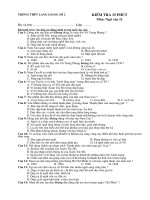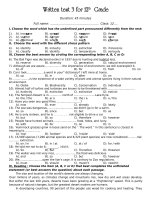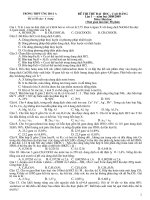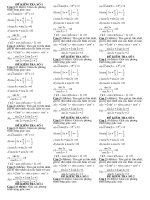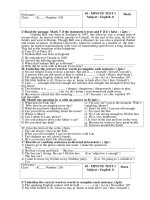Written test 45min (U9+10) 4 mã đề
Bạn đang xem bản rút gọn của tài liệu. Xem và tải ngay bản đầy đủ của tài liệu tại đây (95.81 KB, 12 trang )
Written test 3 for 12
th
Grade
Duration: 45 minutes
Full name: .................................................... Class: 12....
I, Choose the word which has the underlined part pronounced differently from the rest:
1). A). increase B). spread C). weapon D). threat
2). A). scatter B). danger C). nature D). race
3). A). chemical B). which C). each D). change
II, Choose the word with the different stress pattern
4). A). identify B). industry C). extinction D). rhinoceros
5). A). classify B). identify C). temperature D). seriously
III, Choose the best answer by circling the corresponding letter A, B, C or D:
6). The Bali Tiger was declared extinct in 1937 due to hunting and habitat loss.
A). reserve B). diversity C). generation D). natural environment
7). Although we are aware ................... the importance of environment, we still overexploit it.
A). of B). for C). from D). on
8). Can I look....................a word in your" dictionary? I left mine at home.
A). up B). in C). after D). on
9). ...................is the existence of a wide variety of plant and animal species living in their natural environment.
A). Globe B). Biodiversity C). Conservation D). Individual
10). Almost half of turtles and tortoises are known to be threatened with............................... .
A). extinctly B). extinction C). extinctive D). extinct
11). The Simpson Desert is in .............. north of .........................Lake Eyre.
A). the / the B). a/ a C). the / a D). a / the
12). Have you seen any good films ............................?
A). now B). ever C). already D). lately
13). The sea was dangerous, ……...............……. we didn't go in for a swim.
A). so B). since C). but D). as
14). He is only sixteen, and he is . . . . . . . . . not eligible to drive a car
A). but B). so C). therefore D). however
15). People have hunted animals .......................... food, hides, and ivory.
A). with B). for C). on D). in
16). 'Hummock grasses grow in loose sand on the '. The word '' in this sentence is closest in meaning to………………
A). 'top' B). 'bottom' C). 'inside' D). 'side'
17). 15,589 species (7,266 animal species and 8,323 plant species) are now considered ..........risk ............ extinction.
A). on / in B). in / at C). at / of D). for / with
18). He told me not to do it; ________, i did it.
A). So B). But C). Therefore D). However
19). The waiter was not very nice, ......................, the food was delicious.
A). and B). so C). but D). however
20). We...........................open the lion's cage. It is contrary to Zoo regulations.
A). must B). should C). mustn't D). needn't
IV, Reading : Choose the item (A, B, C or D) that best completes the unfinished statement (or best answers
the question) about each passage.
The size and location of the world's deserts are always changing.
Over millions of years, as climates change and mountains rise, new dry and wet areas develop. But within the last
100 years, deserts have been growing at a "frightening" speed. This is partly because of natural changes, but the
greatest desert makers are humans.
In developing countries, 90 percent of the people use wood for cooking and heating. They cut down trees
for firewood. But trees are important. They cool the land under them and keep the sun off the smaller plants.
When leaves fall from a tree, they make the land richer. When the trees are gone, the smaller plants die, and there
is nothing but sand. Yet people must use firewood, raise animals, and grow crops in order to live.
Humans can make deserts, but humans can also prevent their growth.
Algeria planted a green wall of trees across the edge. of the Sahara to' stop the desert sand from spreading.
Mauritania planted a similar wall around Nouakchott, the capital. Iran puts a thin covering of petroleum on sandy
areas and plants trees. The oil keeps the water and small ir the land, and men on motorcycles keep the sheep and
goats away. Other countries build long canals to bring water to desert areas.
Yet land that will probably become desert in the future equals the size of Australia, the United States, and
the former Soviet Union together. Can people stop the growth of the world's deserts and save the land that is so
essential to life?
21. Most people in developing countries__________________________________.
A. planted trees on the edge of the deserts
B. cook on wood fires
C. put oil on sandy areas
D. raise sheep and goats
22. We can infer that men on motorcycles keep the sheep and goats away so that ___________________________.
A. they won't eat the small trees
B. they won't destroy the covering of oil
C. they won't drink water in the canals
D. they won't blow the sand away
23. When all the trees in an area are cut down, .
A. their leaves make the land richer
B. the smaller plants can grow better
C. they cool the land under their leaves
D. there is nothing left but sand
24. The word "frightening" in the first paragraph is closest in meaning to_______________________________.
A. “awful” B. "extremely fast"
C. “powerful” D. "wonderful"
25. According to the passage, which of the following is the most important cause of desertification?
A. The change of climate B. The spread of deserts
C. Human activities D. Cattle destroying trees
V, Listeing: Listen to a paragraph and fill in with the missing information ( ONE word):
The great panda or the panda is an (26)………………..animal. It is found in bamboo forests in the mountains in
central and western China. Nowadays, the panda population is (27) ………………… to be only 600. A panda is from
1.2 to 1.5 meter long and its weight is from 75 to 160 kilograms. Pandas eat (28) ……………….bamboo and it can
live from 20 to 30 years. The panda population decreases due to the (29) ……………..of their habitats and they are
hunted for fur. China has tried hard to protect this beautiful animal from extinction. Wildlife (30)
…………………..have been established to provide pandas with natural environment. Trading on panda fur is banned.
The results have been encouraging and panda population is increasing again.
Answer:
26) ……………………………..
27) ……………………………..
28) ……………………………..
29) ……………………………..
30) ……………………………..
The End.
Đáp án của đề số : 1
01). ; - - - 06). - - - \ 11). - - , - 16). ; - - - 02). ; - - - 07). ; -
- - 12). - - - \ 17). - - , - 03). ; - - - 08). ; - - - 13). ; - - - 18). - -
- \ 04). - / - - 09). - / - - 14). - - , - 19). - - - \05). - / - - 10). - /
- - 15). - / - - 20). - - , -
Wr itten te st 3 fo r 1 2
th
Gra de
Duration: 45 minutes
Full name: .................................................... Class: 12....
I, Choose the word which has the underlined part pronounced differently from the rest:
1). A). society B). sandy C). dry D). geography
2). A). environment B). confident C). chemist D). conference
3). A). danger B). race C). nature D). scatter
II, Choose the word with the different stress pattern
4). A). endangered B). determine C). interview D). pollution
5). A). identify B). extinction C). rhinoceros D). industry
III, Choose the best answer by circling the corresponding letter A, B, C or D:
6). The sea was dangerous, ……...............……. we didn't go in for a swim.
A). since B). as C). but D). so
7). Although we are aware ................... the importance of environment, we still overexploit it.
A). on B). for C). of D). from
8). Almost half of turtles and tortoises are known to be threatened with............................... .
A). extinctly B). extinct C). extinction D). extinctive
9). A / an................... species is a population of an organism which is at risk of becoming extinct.
A). endangerment B). endangered C). dangerous D). endanger
10). You .........................clean the windows. The window-cleaner is coming tomorrow.
A). don't have B). must C). needn't D). mustn't
11). All the countries of the area have ....................... to protect their wildlife but they are rarely enforced.
A). results B). efforts C). reserves D). laws
12). In 1989, a ban was given on all international trade in ivory.
A). destruction B). action C). prohibition D). contamination
13). 15,589 species (7,266 animal species and 8,323 plant species) are now considered ..........risk ............ extinction.
A). for / with B). in / at C). on / in D). at / of
14). Have you seen any good films ............................?
A). ever B). lately C). already D). now
15). The Simpson Desert is in .............. north of .........................Lake Eyre.
A). the / the B). a/ a C). the / a D). a / the
16). People have hunted animals .......................... food, hides, and ivory.
A). in B). for C). with D). on
17). We..............................drive fast; we have plenty of time.
A). can't B). mustn't C). oughtn't D). needn't
18). When she got the news from her family, she could not do anything, .....................cry.
A). and B). so C). but D). however
19). The waiter was not very nice, ......................, the food was delicious.
A). so B). but C). however D). and
20). We...........................open the lion's cage. It is contrary to Zoo regulations.
A). must B). needn't C). mustn't D). should
IV, Choose the item (A, B, C or D) that best completes the unfinished statement (or best answers the
question) about each passage.
In 1782, the bald eagle was chosen as the national bird of the United States because it is a bird of strength
and courage, and was found all over North America and only in North America.
But a little· over 200 years later, the bald eagle had almost disappeared from the country. In 1972, there
were only 3,000 bald eagles in the entire United States. The reason for the bird's decreasing population was
pollution, especially pollution of the rivers by pesticides. Pesticides are chemicals used to kill insects and other
animals that attack and destroy crops. Unfortunately, rain often washes pesticides into rivers. Pesticides pollute
the rivers and poison the fish. Eagles eat these fish and the poison affects their eggs. The eggs have very thin
shells and do not hatch. Eagles only lay only two or three eggs a year. Because many of the eggs did not hatch
and produce more eagles, the number of eagles quickly became smaller.
Today, the American government and the American people are trying to protect the bald eagle. The
number of bald eagles is increasing. It now appears that the American national bird will survive and remain a
symbol of strength and courage.
21. The bald eagle was in danger of extinction mainly because____________________________________.
A. they used to kill insects
B. the rivers were polluted by pesticides
C. they didn't lay enough eggs
D. it was chosen as the national bird
22. One eagle can lay . …………………
A. one or two eggs every six months
B. one or two eggs a year
C. two or three eggs every six months
D. two or three eggs per year
23. The number of bald eagles is now .
A. becoming larger B. decreasing
C. becoming smaller D. in great danger of extinction
24. The bird lays eggs, and then the eggs ________________________________.
A. produce B. 'break C. protect D. hatch
25. The bald eagle's main food is _______________________________.
A. insects B. grass C. fish D. poison
V, Listeing: Listen to a paragraph and fill in with the missing information ( ONE word):
The great panda or the panda is an (26)………………..animal. It is found in bamboo forests in the mountains in
central and western China. Nowadays, the panda population is (27) ………………… to be only 600. A panda is from
1.2 to 1.5 meter long and its weight is from 75 to 160 kilograms. Pandas eat (28) ……………….bamboo and it can
live from 20 to 30 years. The panda population decreases due to the (29) ……………..of their habitats and they are
hunted for fur. China has tried hard to protect this beautiful animal from extinction. Wildlife (30)
…………………..have been established to provide pandas with natural environment. Trading on panda fur is banned.
The results have been encouraging and panda population is increasing again.
Answer:
26) ……………………………..
27) ……………………………..
28) ……………………………..
29) ……………………………..
30) ……………………………..
The end.
Đáp án của đề số : 2
01). - - , - 06). - - - \ 11). - - - \ 16). - / - -02). - - , - 07). -
- , - 12). - - , - 17). - - - \ 03). - - - \ 08). - - , - 13). - - - \ 18). -

